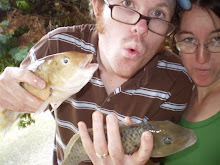 |
| http://www.coldwaterimages.com/green_sea_turtle.html |
Patiently waiting for the baby turtles to appear.
This nest of eggs had been moved from where they had been laid to a safer spot further up the beach. A major threat to sea turtle population is changes to the beach through either 'natural' habitat disturbance or human developments encroaching on their breeding grounds. Watamu Turtle Watch has people walking up and down the beach every single night of the year to both protect female turtles from poachers as they come up to lay and to move nests to safety if required. The Watamu Turtle Watch centre is just down the road from us. Anna and I visited the centre with a group of students that were here for an ASSETS camp. They do a great job of educating the public about sea turtles. They also have a turtle rehab for sick and injured turtles. Most of these turtles come in as a result of fishing or consuming plastic. Over the years Watamu Turtle Watch has helped rescue and care for thousands of turtles. Tour of the sea turtle rehabilitation centre at Watamu Turtle Watch with students from the ASSETS camp.
Back on the beach, just as it was getting dark about 8 turtle hatchlings burst forth from the sand and dashed towards the ocean. Normally at least 50 turtles would hatch at a time, so the remaining eggs were recovered with sand in case they might hatch later that evening. Our role was to slowly walk with them until they got to the water, protecting them from any tempted crab. We didn’t take photos until they were in the water, to avoid confusing them with the flash. My adopted turtle, Bob, was quick off the mark beating a few of his siblings to the water but struggled to make it through the surf. However his persistence paid off and away he went into the big wide ocean. If Bob survives to adulthood and if he is actually a she, Bob will return to this very spot in about 25 years to lay some eggs of her own. Go, Bob go!
Facts about sea turtles: - they spend about 95% of their time under water
- they cannot retract their head or limbs into their shell
- it is estimated that only 1 in 1000 hatchlings reach reproducing age
- Leatherback turtles can grow to 3 meters in length and weigh almost a tonne
- sea turtles are born with magnetite in their brain so that they can relocate their birth place and lay eggs at exactly the same place







Great photos. I am guessing that Lynton came up with the name Bob.
ReplyDeleteDo you know if there has been any research about whether or not turtles who were relocated up the beach as eggs are likely to come back and lay their eggs in the place they were relocated to or to the place their mother laid them (that would be a very tricky long term project so I am guessing the answer is no).
Also, are the turtles at Watamu all one species (green Turtle?) or are there several species there?
Bye for now
Coco